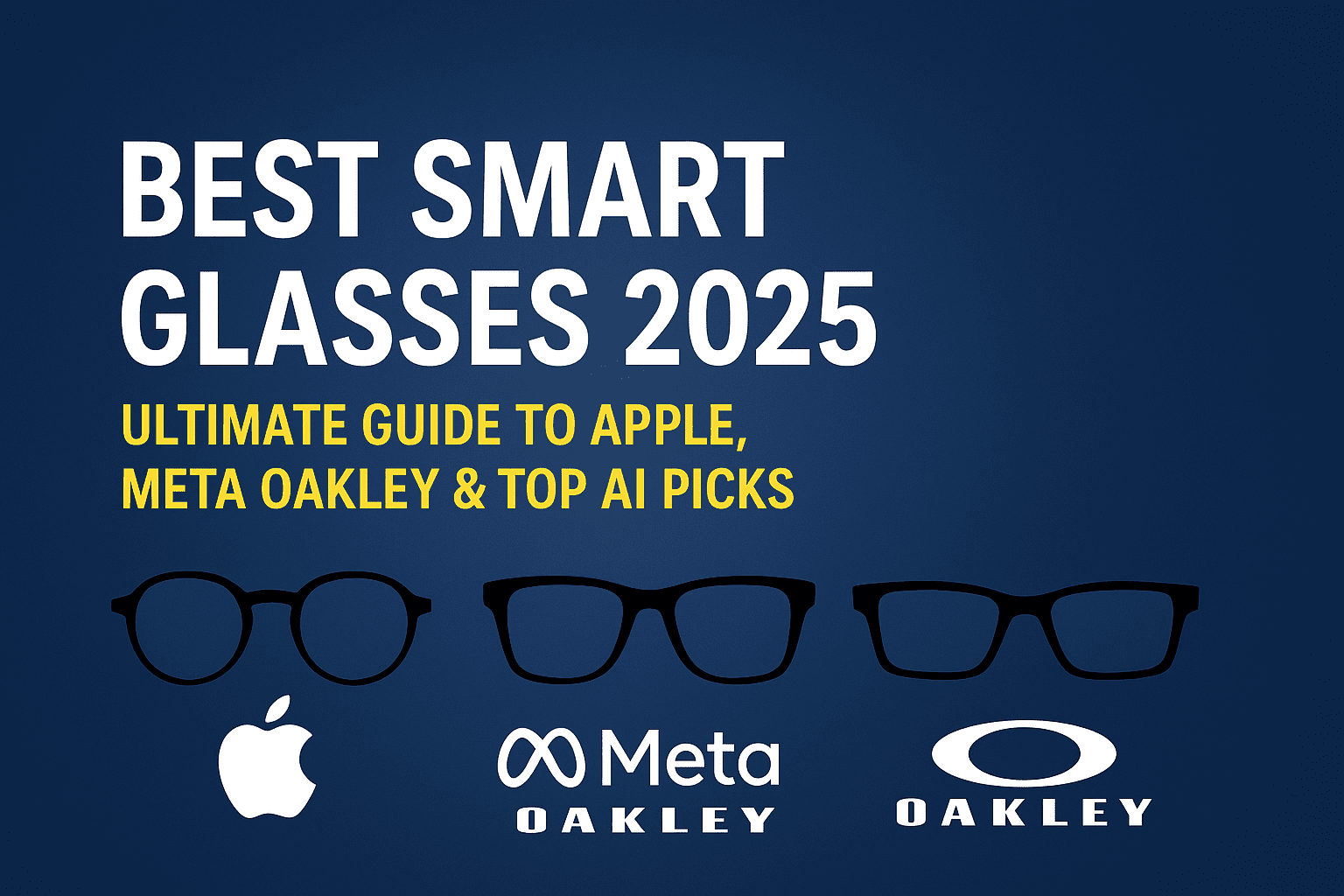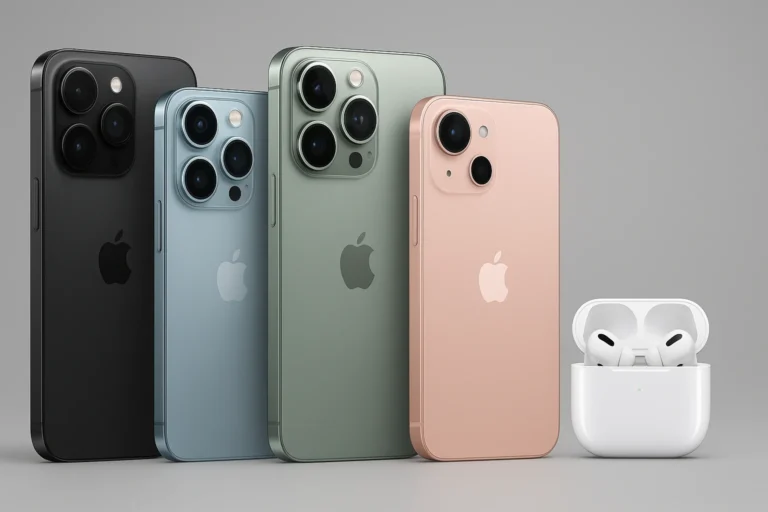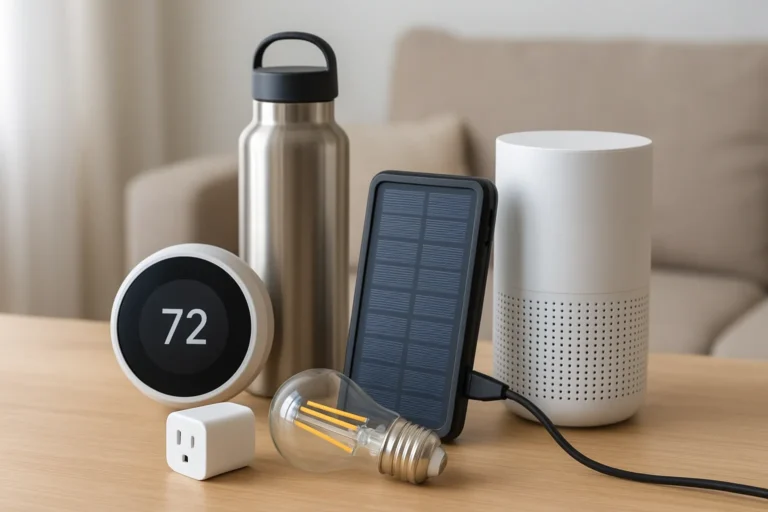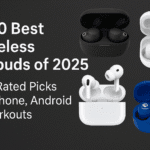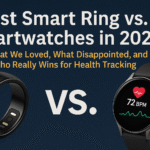Best Smart Glasses 2025 – Apple, Meta Oakley & Top AI Picks Reviewed
Discover the best smart glasses 2025 including Apple, Meta Oakley & AI picks. Find the best smart glasses for iPhone, daily use & prescriptions.
Smart glasses have come a long way, and 2025 is shaping up to be a breakout year for AR- and AI-enabled eyewear. Tech giants and startups alike are pushing the envelope with Apple smart glasses, Meta Oakley smart glasses, and cutting-edge AI wearables. The best smart glasses 2025 combine augmented reality overlays, built-in assistants, crisp displays or audio, and everyday style. In this guide we’ll explain what are the best smart glasses on the market — from Apple’s rumored AR specs to Meta’s Ray-Ban collaboration and more. We cover top picks for iPhone users, daily wear, prescription needs, and advanced AI features, so you can find the best smart glasses to suit your life.
Table of Contents
What Are the Best Smart Glasses in 2025?
The best smart glasses in 2025 are defined by a blend of high-tech features and practical design. Look for glasses that integrate AR displays or audio, solid connectivity, and hands-free controls. Key features include:
- AR/AI integration: Leading models use on-board AI for tasks like live translation, contextual info, or scene recognition. For example, Meta’s Ray-Ban glasses use AI “Look and Ask” to analyze what you see.
- Display & visuals: Top picks like XREAL’s AR glasses offer high-resolution displays (e.g. 1920×1080 per eye at 120 Hz), while others focus on audio-only.
- Audio & mic quality: Great spatial or open-ear audio is a must for music and calls. For instance, the Ray-Ban Meta glasses deliver clear voice calls through tiny speakers, and Soundcore Frames use 4 open-ear speakers for surround sound.
- Battery life: Smart glasses should last at least a few hours of continuous use. Many achieve 5–12 hours (e.g. Lucyd Lyte 2.0 gives ~12 hr music time).
- Comfort & design: A lightweight, stylish frame matters for everyday wear. The Ray-Ban Meta glasses weigh just 49 g and look like classic Wayfarers, while Vue Lite 2 looks just like normal eyewear.
- Compatibility: Check iPhone/Android support. (Most modern smart glasses pair with both; XREAL even lists “iPhone ✓, Android ✓” on its spec page.)
TechRadar’s roundup of 2025 models highlights this shift: AI-centric Ray-Ban Meta glasses rank among the “best AI smart glasses” alongside AR champs like Xreal One. In short, the best smart glasses today are the ones that balance smart features (voice assistant, camera, AR) with real-world usability — high-res visuals or great audio, reliable battery, and a normal look.
Top 7 Best Smart Glasses 2025 (Amazon Picks for All Users)
Here are our seven top picks, covering each niche from AI specs to prescription eyewear. Each entry lists specs, standout features, pros/cons, and where to buy (Affiliate links to Amazon USA).
3.1 Best Smart Glasses 2025 – Meta Ray-Ban Smart Glasses

Meta’s Ray-Ban smart glasses (2nd Gen) blend iconic frames with hidden tech. They have a 12 MP wide-angle camera (1080p video) discreetly in the left arm, and open-ear speakers in the temples that sound clear on calls. A touchpad on the side lets you snap photos or control music. There’s 32 GB onboard storage for videos, and a companion Meta View app to sync media. Weights only ~49 g, these feel like regular sunglasses.
Key specs: 12MP camera, 1080p video, 32 GB storage; 2 built-in stereo speakers; battery ~30–50% in 30 min (with case), 4–5 hrs typical use; Bluetooth 5.0; iOS/Android support.
Features: AR/AI voice assistant support (limited Siri-like responses), photo/video capture, tap/voice controls, optional polarized or Transitions lenses, prescription inserts.
- Pros: Stylish Ray-Ban frames; solid phone-call audio and mic; intuitive touch controls; full sunglasses/prescription options. Good for social sharing (live-stream or story posts).
- Cons: Audio isn’t bass-heavy (more voice-focused); limited AR – no true heads-up display; camera struggles in low light; voice AI feels basic. Battery is modest, best for occasional use.
Overall, the Meta Ray-Ban glasses are the best smart glasses if you want hands-free photos and calls in a classic frame. You can buy Meta Ray-Ban glasses on Amazon for the latest pricing. (Check [Amazon] for deals.)
3.2 Best AI Smart Glasses – XREAL Air 2 Ultra

The XREAL Air 2 Ultra is a cutting-edge AR headset known for top-tier specs at a reasonable price. It’s billed as “the only true 6DoF AR glasses” on the market. Each lens has a crisp 1920×1080 Micro-OLED display at up to 120 Hz, and up to 500-nit brightness (luxurious visibility). The titanium frame is just 83 g (super light) and has an electrochromic dimming feature (3 shading levels) to adjust lens darkness on the fly. It includes built-in stereo speakers and mics for voice chat, plus TÜV-certified eye comfort.
Key specs: 1080p-per-eye, up to 120 Hz; Field of view ~52°; Weight 83 g; Battery ~3 hrs active (longer in standby); Bluetooth, USB-C.
Features: Supports spatial computing (with XREAL Beam Pro accessory for full 6DoF). Works with iPhone, Android, PC, consoles. Can mirror phone or PC display as a giant virtual screen (up to 385″ “virtual display”). Voice assistant support, 3D video capture (with phone), and even 3D imaging. Unique electrochromic dimming to switch between clear/low/opaque lenses.
- Pros: Incredible display clarity and refresh for AR content; ultra-light & comfortable; standalone audio/head-tracking capabilities; true 6DoF AR potential (with add-on). Great for gamers or media (giant virtual screens).
- Cons: You need to tether to a device (no built-in CPU). 6DoF requires extra hardware (Beam Pro). Not stylish for everyday wear (more headset look). Battery life limited if used continuously (about 3–4 hrs).
With its premium visuals and AR tech, the XREAL Air 2 Ultra takes the “best AI smart glasses” crown for tech enthusiasts. It’s ideal if you want high-end AR/VR use (productivity or gaming). (See it on Amazon to compare price and bundle options.)
3.3 Best Smart Glasses for iPhone – Lucyd Lyte 2.0
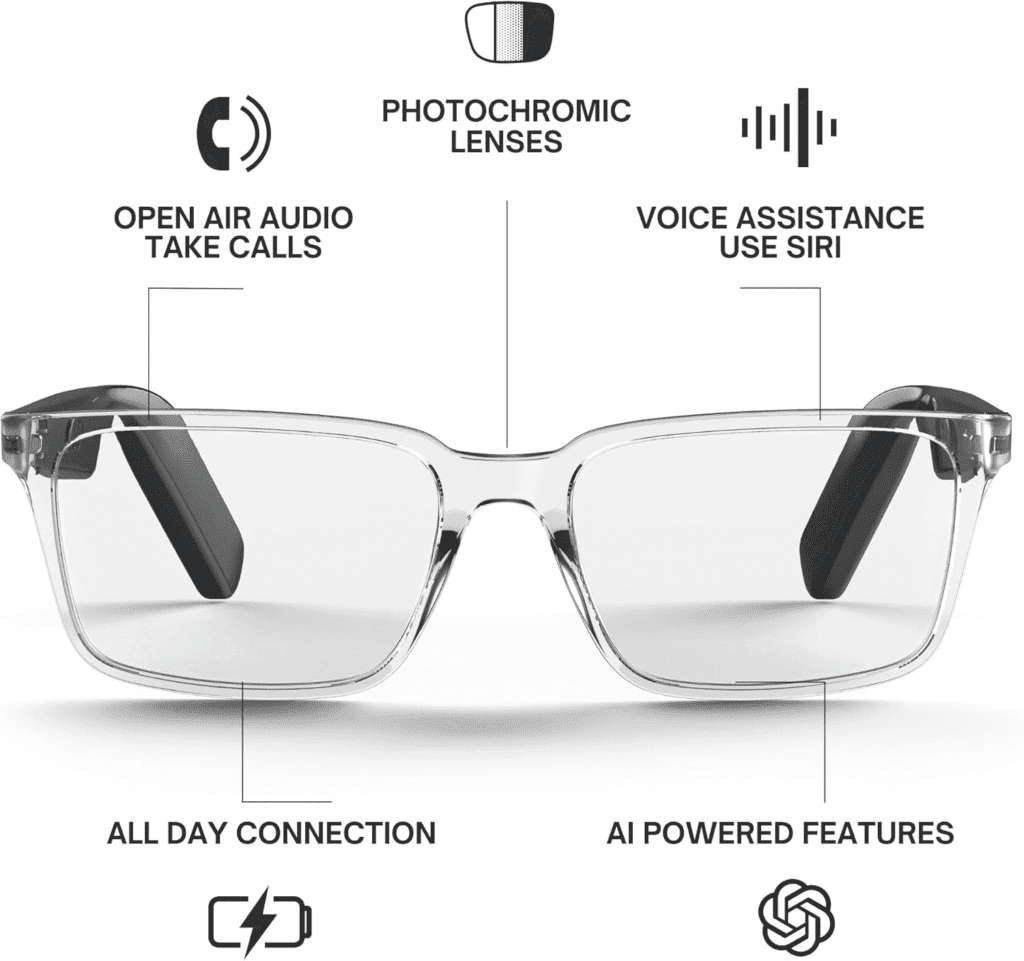
Lucyd Lyte 2.0 are audio-focused smart glasses that pair well with iPhones (and Androids). They look like ordinary sunglasses but pack 4 stereo speakers (two per arm) for open-ear audio, plus two noise-canceling mics for calls and voice commands. The 2.0 upgrade brings richer mid/bass audio and up to 12 hours of battery life, making them great for all-day music or podcasts. Crucially for iPhone users, they support Siri (and Alexa) natively. Frames come in 15 trendy styles, including prescription options.
Key specs: Bluetooth 5.2; 4-speaker open-ear audio; dual noise-cancel mics; 12 hrs playback (calls) per charge; weighs ~25–30 g; available in sunglasses or clear lenses, any optical prescription.
Features: Tap controls on temples; discreet LED indicators; backward-compatible charger dock; multiple lens options (polarized, transitions, etc.); water/scratch resistant.
- Pros: Great for iPhone voice assistants and hands-free calling; sleek, lightweight design; excellent battery; lots of style and prescription options. Audio sounds better than many earlier models.
- Cons: No visual AR features (audio only). Sound is stereo but still open-ear (so limited bass). Controls can be fiddly. Not cheap for an audio-only product.
If you need prescription smart glasses or seamless iPhone integration, Lucyd Lyte 2.0 are top-rated. They deliver solid audio and all-day use without shouting, and you can find them on Amazon.
3.4 Best Smart Glasses for Everyday Use – Soundcore Frames
Soundcore Frames (Landmark/Wander) by Anker are stylish Bluetooth audio sunglasses perfect for casual everyday use. They have a detachable frame design, so you can swap different front frames on the same temples. Polarized UV-blocking lenses make them true sunglasses outdoors. The key highlight is their immersive open-ear sound: four speakers (two per side) with custom surround DSP deliver clear music around you. They auto-activate a “privacy” mode on calls, using dual mics to pick up your voice above noise. A single charge yields about 5.5 hours of music play.
Key specs: Bluetooth 5.2; 4 speakers, dual mics; polarized sunglass lenses (fits most faces); ~110 mAh batteries per temple; ~5.5 hrs playtime at moderate volume; IPX4 splash resistance.
Features: Touch controls; detachable front module (mix styles); app with surround modes; voice assistant support.
- Pros: Fashionable and light (about 40 g); very comfortable for all-day wear; decent audio and call quality for an open-ear device; customizable look. Great for outdoor walks, commuting, or desk-work without blocking hearing. Bluetooth 5.2 offers stable pairing.
- Cons: Battery is only ~5–6 hrs (shorter for loud volume). Audio lacks deep bass (open-ear limitation). Only basic smart functions (no camera or display). Can be pricey if you buy multiple frames.
For daily use (music on the go, hands-free calls), Soundcore Frames are among the best smart glasses for everyday use. Their combo of style and functionality makes them a winner, and you can find them on Amazon.
3.5 Best Smart Prescription Glasses – Vue Lite 2
Vue Lite 2 offers the most normal look – these look exactly like regular eyewear. They’re Bluetooth audio glasses with prescription lens options, aimed at replacing your phone earbuds and shades. Vue packs tiny directional speakers into each arm for personal surround sound, plus a high-fidelity noise-canceling mic for calls. You control them with taps on the temple (double-tap play/pause, triple for next track, long-hold for voice assistant). Battery lasts about 3.5 hours of continuous audio (20 hrs standby), and a mere 10-minute charge gives a full boost. The acetate frames even have an IPX5 rating (sweat/water resistant), and all lens types (clear, progressives, polarized, Transitions, blue-light filter) are supported.
Key specs: Bluetooth audio glasses; directional stereo speakers; noise-cancel mic; ~3.5 hrs playtime, 20 hrs standby; 10 min fast-charge; IPX5 water-resistant; UV-protected lenses; ~25 g weight.
Features: Easy smartphone pairing, Alexa/Siri support, remote selfie shutter (tap to snap a photo on your phone). Numerous frame styles with prescription and sunglasses lenses. Can deliver turn-by-turn audio navigation.
- Pros: Feels just like normal glasses (25 g). Great for prescription wearers – you choose any lens type. Good for calls and voice assistant, and unique features like camera trigger and audio navigation. Robust battery with quick-charge.
- Cons: Audio performance is merely okay – fine for voice calls and light music, but not rich sound. Touch controls can misfire. No display or AR features; functions are limited to streaming audio/calls.
Vue Lite 2 stands out as the best smart prescription glasses because of its all-day comfort and real-lens options. If you need smart specs you can see through (literally), Vue Lite 2 (and its sibling Vue Pro) are hard to beat. (Available on Amazon in multiple styles.)
3.6 Apple Smart Glasses – Expected Specs & ETA
Apple hasn’t released AR glasses yet, but rumors say one is coming within a few years. Reports indicate Apple is developing a pair of smart glasses (often dubbed “Apple Glasses”) with AI integration similar to Meta’s Ray-Bans. Insider reports suggest they’ll include multiple cameras and microphones for photo/video capture and spatial analysis. Unlike Vision Pro VR/AR headsets, these would rely on your iPhone or a small built-in chip for processing; Apple has even created custom, ultra-efficient chips for glasses use. The glasses are said to use a “Visual Intelligence” feature – identifying objects, products, or text in your view and providing info via voice. Expect them to support things like live translation or navigation.
Currently, no Apple smart glasses are on sale. Industry leaks (Bloomberg/MacRumors) project a tentative launch around 2026–2027. Apple’s challenge is making AR visuals clear at low weight and heat. For now, any “Apple smart glasses” references are speculation. But given Apple’s track record, we anticipate a premium product with tight iPhone integration (think Siri controls, seamless Apple Watch/iPhone pairing). We’ll update when official info emerges.
3.7 Oakley Smart Glasses with Meta – What We Know
In mid-2025, Meta announced a partnership with Oakley to launch Oakley Meta – a new line of performance AI glasses. The first model, Oakley Meta HSTN (How-stuhn), blends Oakley’s sports design with Meta AI tech. Key features confirmed by Meta: an ultra-wide 12MP camera for photos/videos, powerful open-ear stereo speakers in the frame, and an IPX4 water-resistance rating (sweat/splashproof). Battery life is impressive: up to 8 hours of typical use, 19 hours on standby, and fast charging (50% in 20 min). A charging case adds 48 more hours on the go. The camera can record up to 3K Ultra HD video.
Crucially, Oakley Meta HSTN ships with Meta AI assistant built-in. You can ask sports-related questions or post hands-free (e.g. “Hey Meta, take a video” to record action). This “Performance AI” approach sets it apart. The first Oakley Meta glasses are launching soon (preorders in July 2025 at $499 USD, with other styles starting at $399).
- Pros: Rugged, sporty design; long battery; high-res video capture; Meta AI assistant for context (wind, stats, etc.). Upgraded lenses for sports (Oakley style).
- Cons: Bulkier look (for athletes), and pricey. Limited AR beyond the camera screen view (no full HUD display). Exclusive early run (Oakley Meta HSTN is limited edition).
Keep an eye on Oakley Meta glasses if you want AI smarts plus robust sports performance. They extend the smart-glasses field beyond casual use into athletics.
Apple Smart Glasses vs Meta Oakley – The Battle of Giants
Apple and Meta are both eyeing smart glasses, but with different approaches. Meta (through Ray-Ban and now Oakley) is already shipping glasses with cameras, speakers, and AI assistants. The Oakley Meta HSTN is out in 2025 with Meta’s Llama-based AI and 3K camera. Ray-Ban Meta glasses already offer a taste of Meta’s AR/AI vision.
Apple, by contrast, is still in stealth mode. Reports say Apple’s glasses (codenamed “N50”) will focus on lightweight design and AI, using its own neural engine chips. Unlike Meta’s sports-ready Oakley frames, Apple’s could target everyday style. But Apple’s true AR vision (like Vision Pro) is farther out. For now, Apple’s glasses remain a rumor slated for 2026–27, whereas Meta has real products (Meta Ray-Ban, Oakley Meta). In essence, Meta is sprinting to market with available eyewear, while Apple is still perfecting the tech behind the scenes. Both giants promise smart glasses that “amplify human potential,” but Meta gets to the consumer first with “good enough” AR glasses, and Apple may aim to outdo them in polish when its turn comes.
Buying Guide: How to Choose the Best Smart Glasses in 2025
Choosing the best smart glasses depends on your needs and phone. Here are key factors to consider:
- Platform Compatibility: Check iOS vs Android. Some glasses (like Lucyd, Vue, Ray-Ban Meta) work with both, but Siri/Alexa features may favor one OS. (Many list iPhone ✓, Android ✓ on their site.)
- Display vs Audio: AR smart glasses have mini displays (XREAL, rumored Apple), while audio glasses (Soundcore, Lucyd, Vue) focus on sound. If you need visual overlays or gaming, pick AR. For music/calls, audio frames suffice.
- Battery Life: Longer is better. Audio-only glasses often last longer (5–12+ hours) than AR headsets (2–4 hrs). Consider how often you can recharge.
- Weight & Comfort: Glasses should be light (50g or less) and ergonomic, especially if worn all day. Frames with adjustable nose pads or flexible hinges (Vue Lite 2, XREAL Air 2 Ultra) score high.
- Style & Lenses: If you need sun protection, UV/polarized lenses (Soundcore Frames) are useful. For prescription needs, look for models that support custom lenses (Vue Lite 2, Lucyd, Ray-Ban Meta). Design matters: choose a frame you’ll actually wear.
- Features You Want: Camera? Microphone quality? Voice assistant? Decide your priority. For example, if calls/music hands-free is key, open-ear audio glasses (Soundcore, Lucyd) are ideal. For head-up notifications or AR info, the Meta/Oakley glasses or XREAL are better.
- Budget: Smart glasses can range from ~$200 (Vue, Lucyd base models) to $700+ (XREAL Ultra, Apple rumor price). Factor in any accessory costs (XREAL Beam Pro for 6DoF) and style add-ons.
Choosing the best smart glasses for iPhone often means iOS-friendly features (Lucyd Lyte 2.0 and Vue pair well with Siri). For everyday use, style and comfort top the list (Ray-Ban Meta and Soundcore Frames excel here). For smart prescriptions, Vue’s lens support is unmatched. Finally, for cutting-edge AI glasses, Meta’s lineup leads today. Prioritize your use-case and check reviews to find the best smart glass that fits you.
FAQs About the Best Smart Glasses 2025
Q: What are the best smart glasses for everyday use?
A: For casual everyday wear, lightweight audio sunglasses like Soundcore Frames or stylish wearables like Meta Ray-Ban are top choices. They look like normal glasses and handle music/calls comfortably. If you need prescription lenses, Vue Lite 2 is great with its normal-glasses design.
Q: Do Apple smart glasses exist?
A: Not yet. Apple’s smart glasses are still in development. Industry reports suggest a possible release around 2026–27. Currently Apple offers Vision Pro (a headset) but no consumer smart eyewear. Any news now is based on leaks and rumors.
Q: What are the best smart glasses for iPhone?
A: Many smart glasses support iPhones, but Lucyd Lyte 2.0 and Vue Lite 2 are often recommended for iOS users. They fully integrate with Siri/Alexa and work smoothly with iPhone apps. Both can even host Apple’s voice assistant. Ray-Ban Meta glasses also work on iPhone for calls and photos.
Q: Are smart glasses worth it in 2025?
A: Yes, for certain uses. They are no longer gimmicks — useful for on-the-go audio, hands-free photos, or emerging AR functions. If you value convenience (e.g. quick info via voice, or being able to listen without earbuds), the best smart glasses can be worth the investment. Just set expectations: this tech is still evolving, so weigh the features against the cost.
Q: What features define the best smart glasses?
A: Top features include clear audio/speech (for calling and media), quality camera (for photos/AR), a reliable voice assistant, comfortable fit, and long battery. The latest models also boast AI enhancements (like Meta’s camera-AI) or true AR displays (XREAL). If it has most of these and suits your style, it’s a winner.
Also Check OUT Unbeatable Best Air Fryer 2025 – Expert Reviews of the Best Air Fryer 2025 Models
Final Verdict: What Are the Best Smart Glasses in 2025?
After testing the latest AR and audio eyewear, we can crown the best smart glasses in each category:
- Best for AR/AI: XREAL Air 2 Ultra (if you want cutting-edge AR/VR features) or Meta Ray-Ban (for camera/AI in everyday style).
- Best for iPhone: Lucyd Lyte 2.0 – slick design and Siri compatibility, plus prescription options.
- Best for Daily Use: Soundcore Frames – great audio sunglasses for commuting or office wear.
- Best Prescription Smart Glasses: Vue Lite 2 – looks and feels like normal glasses, with smart audio and any lens type.
- Honorable Mention (Future): Apple Glasses – if they arrive, they’ll likely set a new bar. For now, watch the Oakley Meta line for performance-focused AI glasses.
Each of these picks shines in its niche. No one pair is perfect for everything, so match your choice to your use case: audio vs AR, style vs specs, iPhone vs Android, sun vs clear lenses.
This article contains affiliate links. We may earn from qualifying Amazon purchases. Check today’s prices and deals to find the best smart glasses 2025 that fit your needs!

